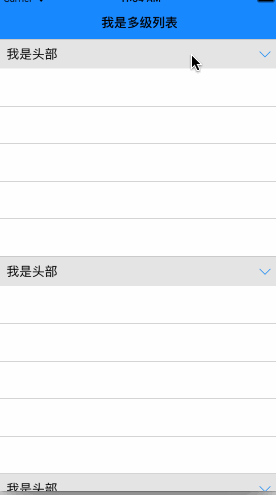
- dispatch_async&dispatch_sync
- 【读书笔记】GCD-DispatchQueue
- 【读书笔记】iOS网络-应用间通信
- objective-c语法快速过(3)
- 【读书笔记】iOS-引用计数
- 基本网络请求
- 【iOS】在页面中展示gif动图
- 如何实现IOS_SearchBar搜索栏及关键字高亮
- IOS学习笔记----15/09/06
- 编写高质量的Objective-C代码(转)
- iOS Gif图片展示N种方式(原生+第三方)
- iOSUI进阶05
- 【学习笔记】【C语言】位运算
- Objective-C中的分类与协议
- IOS之swift第一课基础代码
- iOS自定义button抖动效果并实现右上角删除按钮
- swift皮筋弹动发射飞机
- 手把手教你使用SizeClass
- IOS基础——alloc、init和new方法
- [iOS基础控件-6.9]聊天界面Demo
- 高仿美团应用客户端项目源码
- IOS开发之XML解析以及下拉刷新上拉加载更多的分享
- UITableView随笔笔记
- [iOS基础控件-5.5]代理设计模式(基于”APP列表练习)
- 根据显示的字符多少来做Label的自适应高度
- IOS实现验证码倒计时功能(一)
- iOS链式编程框架介绍之LinkBlock(iOS链式编程)
- Cheatsheet:201401.15~01.30
- iOSUIImage剪切圆形
- 加载和解析XML文件
IOS实现展开二级列表效果
作者:佚名 IOS开发编辑:admin 更新时间:2022-07-23
先来看看效果图

用法(类似UITableView)
初始化XDMultTableView
#import "XDMultTableView.h" ... @property(nonatomic, readwrite, strong)XDMultTableView *tableView; _tableView = [[XDMultTableView alloc] initWithFrame:CGRectMake(0, 64, self.view.frame.size.width, self.view.frame.size.height-64)]; _tableView.openSectionArray = [NSArray arrayWithObjects:@1,@2, nil]; _tableView.delegate = self; _tableView.datasource = self; _tableView.backgroundColor = [UIColor whiteColor]; [self.view addSubview:_tableView];
实现数据源
- (NSInteger)mTableView:(XDMultTableView *)mTableView numberOfRowsInSection:(NSInteger)section{
return 5;
}
- (XDMultTableViewCell *)mTableView:(XDMultTableView *)mTableView
cellForRowAtIndexPath:(NSIndexPath *)indexPath{
static NSString *cellIdentifier = @"cell";
UITableViewCell *cell = [mTableView dequeueReusableCellWithIdentifier:cellIdentifier];
if (cell == nil)
{
cell = [[UITableViewCell alloc] initWithStyle:UITableViewCellStyleDefault reuseIdentifier:cellIdentifier];
}
UIView *view = [[UIView alloc] initWithFrame:cell.bounds] ;
view.layer.backgroundColor = [UIColor whiteColor].CGColor;
view.layer.masksToBounds = YES;
view.layer.borderWidth = 0.3;
view.layer.borderColor = [UIColor lightGrayColor].CGColor;
cell.backgroundView = view;
cell.selectionStyle = UITableViewCellSelectionStyleNone;
return cell;
}
- (NSInteger)numberOfSectionsInTableView:(XDMultTableView *)mTableView{
return 6;
}
-(NSString *)mTableView:(XDMultTableView *)mTableView titleForHeaderInSection:(NSInteger)section{
return @"我是头部";
}
实现代理
- (CGFloat)mTableView:(XDMultTableView *)mTableView heightForRowAtIndexPath:(NSIndexPath *)indexPath{
return 50;
}
- (CGFloat)mTableView:(XDMultTableView *)mTableView heightForHeaderInSection:(NSInteger)section{
return 40;
}
- (void)mTableView:(XDMultTableView *)mTableView willOpenHeaderAtSection:(NSInteger)section{
NSLog(@"即将展开");
}
- (void)mTableView:(XDMultTableView *)mTableView willCloseHeaderAtSection:(NSInteger)section{
NSLog(@"即将关闭");
}
- (void)mTableView:(XDMultTableView *)mTableView didSelectRowAtIndexPath:(NSIndexPath *)indexPath{
NSLog(@"点击cell");
}
列表展开关闭的实现原理
在section header注册一个手势
//section header view 设置tag值为section view.tag = section; UITapGestureRecognizer *tap = [[UITapGestureRecognizer alloc] initWithTarget:self action:@selector(tapHeader:)]; [view addGestureRecognizer:tap];
手势的响应事件
- (void)tapHeader:(UITapGestureRecognizer *) tap {
NSInteger section = tap.view.tag;
NSNumber *sectionObj = [NSNumber numberWithInteger:section];
UIImageView *imageView = (UIImageView *)[tap.view viewWithTag:100];
//_multopenSectionArray 用于记录每个 section的展开和关闭状态
if ([_multopenSectionArray containsObject:sectionObj]) {
NSArray *deleteArray = [self buildDeleteRowWithSection:section];
[_multopenSectionArray removeObject:sectionObj];
//想关闭的section的所有indexPath
[_tableView deleteRowsAtIndexPaths:deleteArray withRowAnimation:UITableViewRowAnimationFade];
[UIView animateWithDuration:0.3 animations:^{
imageView.transform = CGAffineTransformMakeRotation(-M_PI/2);
}];
}else{
[_multopenSectionArray addObject:sectionObj];
//想展开的section的所有indexPath
NSArray *insertArray = [self buildInsertRowWithSection:section];
[_tableView insertRowsAtIndexPaths:insertArray withRowAnimation:UITableViewRowAnimationFade];
[UIView animateWithDuration:0.3 animations:^{
imageView.transform = CGAffineTransformMakeRotation(0);
}];
}
}
总结
以上就是IOS实现展开二级列表效果的全部内容,希望对大家学习开发IOS能有所帮助。
- 上一篇文章: IOS实现碎片化动画详解
- 下一篇文章: iOS基础知识之@property 和 Ivar 的区别